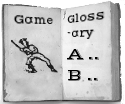Hildegarde: Difference between revisions
No edit summary |
No edit summary |
||
| Line 9: | Line 9: | ||
<p>The game was played with 15-inch paddles and 2.5-inch rubber balls. Three poles, several yards apart, are both the bases and targets that can put batters and runners out. Teams of from two to fifteen are accommodated, and a "scrub" form is an option when very few players are available. A pitcher throws pitches with one foot on a foot-base located amid the three bases and at a distance of ten feet. </p> | <p>The game was played with 15-inch paddles and 2.5-inch rubber balls. Three poles, several yards apart, are both the bases and targets that can put batters and runners out. Teams of from two to fifteen are accommodated, and a "scrub" form is an option when very few players are available. A pitcher throws pitches with one foot on a foot-base located amid the three bases and at a distance of ten feet. </p> | ||
<p>Some interesting variations from cricket and base ball":</p> | <p>Some interesting variations from cricket and base ball":</p> | ||
<p>[] The batter can adjust the height of the (roughly one-foot by two-feet) "strike zone to her/his taste.</p> | <p>[1] The batter can adjust the height of the (roughly one-foot by two-feet) "strike zone to her/his taste.</p> | ||
<p>[2] Batters can employ a bat in both hands if desired.</p> | <p>[2] Batters can employ a bat in both hands if desired.</p> | ||
<p>[3] The number of outs per inning depends on team size, with eleven-player side, for instance, seven outs retires a side.</p> | <p>[3] The number of outs per inning depends on team size, with eleven-player side, for instance, seven outs retires a side.</p> | ||
Revision as of 17:19, 3 February 2014
| Game | Hildegarde |
|---|---|
| Game Family | Baseball |
| Location | England |
| Regions | Britain |
| Eras | Derivative, 1800s |
| Invented | Yes |
| Tags | |
| Description | Hildegarde is described in an 1881 publication as a new English game that was "a combination of the noble old English one of Cricket with the popular American one of Base-ball. It is especially adapted in its arrangements and implements to fit it for the use of ladies." The game was played with 15-inch paddles and 2.5-inch rubber balls. Three poles, several yards apart, are both the bases and targets that can put batters and runners out. Teams of from two to fifteen are accommodated, and a "scrub" form is an option when very few players are available. A pitcher throws pitches with one foot on a foot-base located amid the three bases and at a distance of ten feet. Some interesting variations from cricket and base ball": [1] The batter can adjust the height of the (roughly one-foot by two-feet) "strike zone to her/his taste. [2] Batters can employ a bat in both hands if desired. [3] The number of outs per inning depends on team size, with eleven-player side, for instance, seven outs retires a side. [4] After completing a circuit, a batter completes the at-bat, unlike in cricket, so the entire batting order is continually active. [5] We have the impression that running is compulsory when a ball is batted. The pamphlet describes a second game, Ladies' Cricket, that can be played with the same equipment, but employing 2 bases and using more cricket-like rules. Explaining the niche for Hildegarde, the instruction (page 4) explain that "The best possible game hitherto has been the old game of Ball, called in some places Tut-Ball; but in this there is no scope for the exhibition of an individual skill, and no object is to be gained worth the winning." Describing the ball, the point is made (page 7) that "There is no good out-door game without a Ball in it . . . " |
| Sources | Leonora "(pseud)", The New Out-door Games of Hildegarde and Ladies' Cricket (Macdougall and Son, Sheffield, 1881), 16 pp. [Accessed 2/3/2014 via a Google Books search <"hildegarde and ladies">.] A tip on Hildegarde was provided by John Thorn, email to Protoball, 2/3/2014.
|
| Source Image | [[Image:|left|thumb]] |
| Comment | Is there evidence that this game was actually played, or was it publicized to sell equipment? What features does Hildegard have that contemporary stoolball lacked? Do we know what years and what locations saw this game?
Edit with form to add a comment |
| Query | Edit with form to add a query |
| Has Supplemental Text |
Comments
<comments voting="Plus" />
